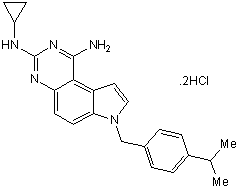SCH 79797 dihydrochloride
Chemical Name: N3-Cyclopropyl-7-[[4-(1-methylethyl)phenyl]methyl]-7H-pyrrolo[3,2-f]quinazoline-1,3-diamine dihydrochloride
Purity: ≥99%
Biological Activity
SCH 79797 dihydrochloride is a potent, selective non-peptide PAR1 receptor antagonist (IC50 = 70 nM). Inhibits haTRAP-induced- but not γ-thrombin-, ADP- or collagen-induced human platelet aggregation. Selectively blocks PAR1 agonist- or thrombin-induced increases in cytosolic Ca2+ in vascular smooth muscle cells. Also broad spectrum antibiotic. Kills bacteria by a dual action of inhibiting dihydrofolate reductase and interfering with bacterial cell membrane integrity.Technical Data
The technical data provided above is for guidance only.
For batch specific data refer to the Certificate of Analysis.
Tocris products are intended for laboratory research use only, unless stated otherwise.
Background References
-
Structure-activity relationships of pyrroloquinazolines as thrombin receptor antagonists.
Ahn et al.
Bioorg.Med.Chem.Lett., 1999;9:2073 -
Inhibition of cellular action of thrombin by N3-cyclopropyl-7-{[4-(1-methylethyl)phenyl]methyl}-7H-pyrrolo[3,2-f]quinazoline-1,3-diamine (SCH 79797), a nonpeptide thrombin receptor antagonist.
Ahn et al.
Biochem.Pharmacol., 2000;60:1425 -
A role for proteinase-activated receptor 2 and PKC-ε in thrombin-mediated induction of decay-accelerating factor on human endothelial cells.
Lidington et al.
Am.J.Physiol.Cell Physiol., 2005;289:C1437 -
A dual-mechanism antibiotic kills Gram-negative bacteria and avoids drug resistance.
Martin et al.
Cell, 2020;S0092-8674:30567
Product Datasheets
Reconstitution Calculator
Molarity Calculator
Citations for SCH 79797 dihydrochloride
The citations listed below are publications that use Tocris products. Selected citations for SCH 79797 dihydrochloride include:
28 Citations: Showing 1 - 10
-
Thrombin induces morphological and inflammatory astrocytic responses via activation of PAR1 receptor.
Authors: Chen Et al.
Cell Death Discov. 2022;8:189
-
A dual-mechanism antibiotic kills Gram-negative bacteria and avoids drug resistance.
Authors: Martin Et al.
Cell 2020;S0092-8674:30567
-
Cub domain-containing protein 1 negatively regulates TGF-β signaling and myofibroblast differentiation.
Authors: Noskovičová Et al.
Am J Physiol Lung Cell Mol Physiol 2018;314:L695
-
PAR1?mediated c?Jun activation promotes heat stress?induced early stage apoptosis of human umbilical vein endothelial cells.
Authors: Zhang Et al.
Mol Med Rep 2017;15:2595
-
Interference with protease-activated receptor 1 alleviates neuronal cell death induced by lipopolysaccharide-stimulated microglial cells through the PI3K/Akt pathway
Authors: Li Et al.
Nature Communications 2016;6:38247
-
PAR1 inhibition suppresses the self-renewal and growth of A2B5-defined glioma progenitor cells and their derived gliomas in vivo.
Authors: Auvergne Et al.
Oncogene 2016;35:3817
-
Multiple Growth Factors, But Not VEGF, Stimulate Glycosaminoglycan Hyperelongation in Retinal Choroidal Endothelial Cells.
Authors: Gwairi Et al.
Int J Biol Sci 2016;12:1041
-
Thrombin-induced reactive oxygen species generation in platelets: A novel role for protease-activated receptor 4 and GPIbα.
Authors: Carrim Et al.
Proc Natl Acad Sci U S A 2015;6:640
-
PAR1 signaling regulates the retention and recruitment of EPCR-expressing bone marrow hematopoietic stem cells.
Authors: Gur-Cohen Et al.
Int J Oncol 2015;21:1307
-
Protease-activated receptor 2 (PAR2) is upregulated by Acanthamoeba plasminogen activator (aPA) and induces proinflammatory cytokine in human corneal epithelial cells.
Authors: Tripathi Et al.
Invest Ophthalmol Vis Sci 2014;55:3912
-
Thrombin conducts epithelial-mesenchymal transition via protease-activated receptor-1 in human gastric cancer.
Authors: Otsuki Et al.
J Biol Chem 2014;45:2287
-
Induction of tumor necrosis factor (TNF) release from subtypes of T cells by agonists of proteinase activated receptors.
Authors: Yang Et al.
Mediators Inflamm 2014;2013:165453
-
Tumor MMP-1 activates endothelial PAR1 to facilitate vascular intravasation and metastatic dissemination.
Authors: Juncker-Jensen Et al.
Cancer Res 2013;73:4196
-
Role of SCH79797 in maintaining vascular integrity in rat model of subarachnoid hemorrhage.
Authors: Yan Et al.
Nat Med 2013;44:1410
-
Novel role for p21-activated kinase 2 in thrombin-induced monocyte migration.
Authors: Gadepalli Et al.
Redox Biol 2013;288:30815
-
Kallikrein 6 is a novel molecular trigger of reactive astrogliosis.
Authors: Scarisbrick Et al.
Cytotechnology 2012;393:355
-
Thrombin activity associated with neuronal damage during acute focal ischemia.
Authors: Chen Et al.
J Neurosci 2012;32:7622
-
Host gene-encoded severe lung TB: from genes to the potential pathways.
Authors: Ganachari Et al.
Genes Immun 2012;13:605
-
Identification of an antithrombotic allosteric modulator that acts through helix 8 of PAR1.
Authors: Dowal Et al.
J Neurosci 2011;108:2951
-
A few immobilized thrombins are sufficient for platelet spreading.
Authors: Okamura Et al.
Biophys J 2011;100:1855
-
Plasma fibronectin promotes lung metastasis by contributions to fibrin clots and tumor cell invasion.
Authors: Malik Et al.
Cancer Res 2010;70:4327
-
Granzyme A and thrombin differentially promote the release of interleukin-8 from alveolar epithelial A549 cells.
Authors: Yoshikawa Et al.
Proc Natl Acad Sci U S A 2010;62:325
-
Activation of protease-activated receptors 3 and 4 accelerates tissue factor-induced thrombin generation on the surface of vascular smooth muscle cells.
Authors: Vidwan Et al.
Arterioscler Thromb Vasc Biol 2010;30:2587
-
Alpha-synuclein activates microglia by inducing the expressions of matrix metalloproteinases and the subsequent activation of protease-activated receptor-1.
Authors: Lee Et al.
J Immunol 2010;185:615
-
The activation of Proteinase-Activated Receptor-1 (PAR1) mediates gastric cancer cell proliferation and invasion.
Authors: Fujimoto Et al.
BMC Cancer 2010;10:443
-
A matrix metalloproteinase-1/protease activated receptor-1 signaling axis promotes melanoma invasion and metastasis.
Authors: Blackburn Et al.
Oncogene 2009;28:4237
-
Thrombin-induced expression of endothelial CX3CL1 potentiates monocyte CCL2 production and transendothelial migration.
Authors: Popovic Et al.
J Leukoc Biol 2008;84:215
-
Proteinase-activated receptors 1 and 4 counter-regulate endostatin and VEGF release from human platelets.
Authors: Ma Et al.
Biol Chem 2005;102:216
FAQs
No product specific FAQs exist for this product, however you may
View all Small Molecule FAQsReviews for SCH 79797 dihydrochloride
Average Rating: 5 (Based on 1 Review)
Have you used SCH 79797 dihydrochloride?
Submit a review and receive an Amazon gift card.
$25/€18/£15/$25CAN/¥75 Yuan/¥2500 Yen for a review with an image
$10/€7/£6/$10 CAD/¥70 Yuan/¥1110 Yen for a review without an image
Filter by:


